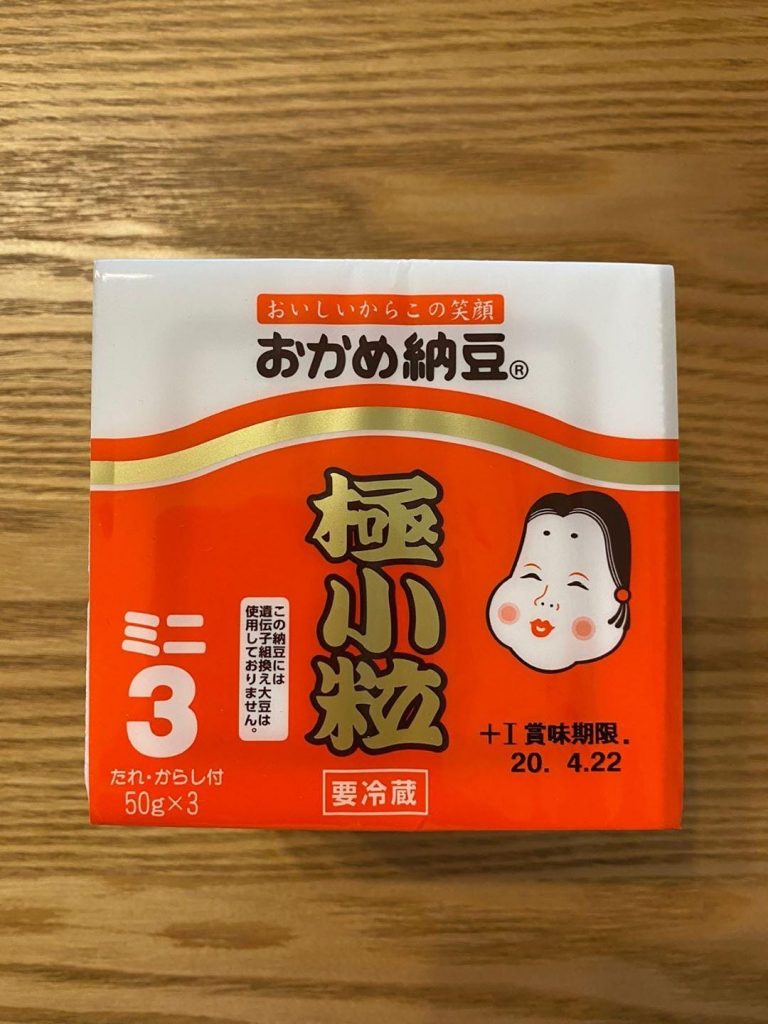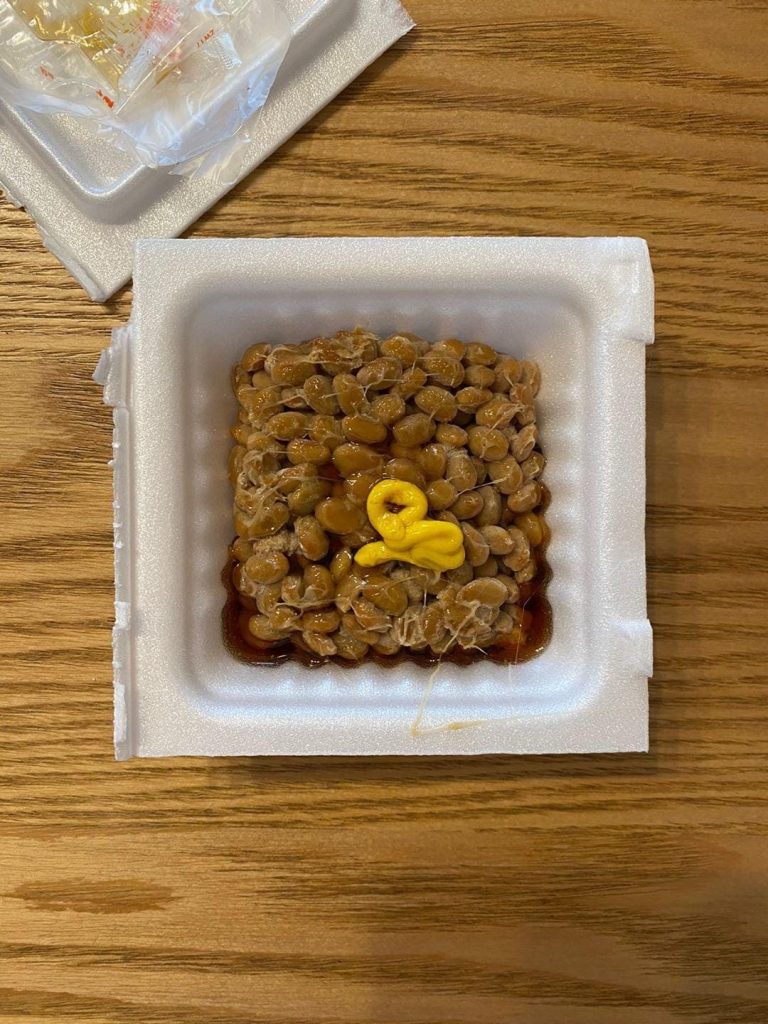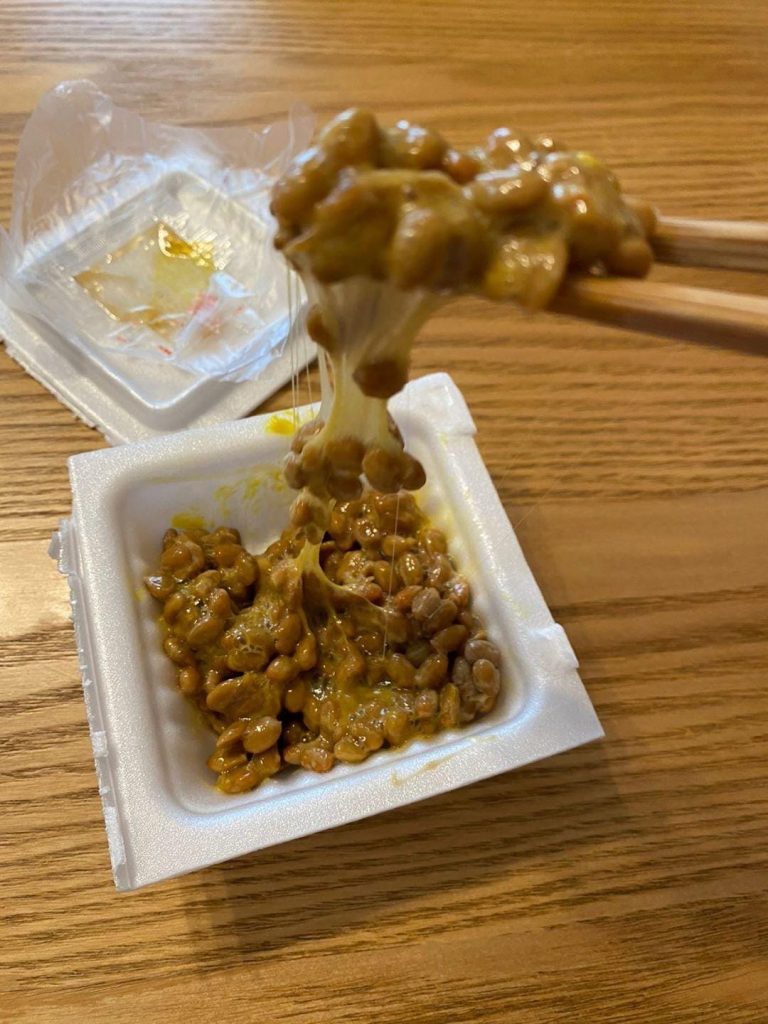My fascination with weird food came with travelling. My first introduction to “strange food” was balut in the Philippines, and I couldn’t eat it. A few years later, on business trips from my job in Kazakhstan, I discovered the food markets of Beijing and Seoul. Again I regret (now) that I didn’t try the Chinese cockroach-on-a-stick or the live octopus (Sannakji) in South Korea, Fast forward another few years and at last, my Far Eastern travels with the twins, gave me the opportunity to practice more and more “food bravery” as at last I tried things like scorpion and snake.
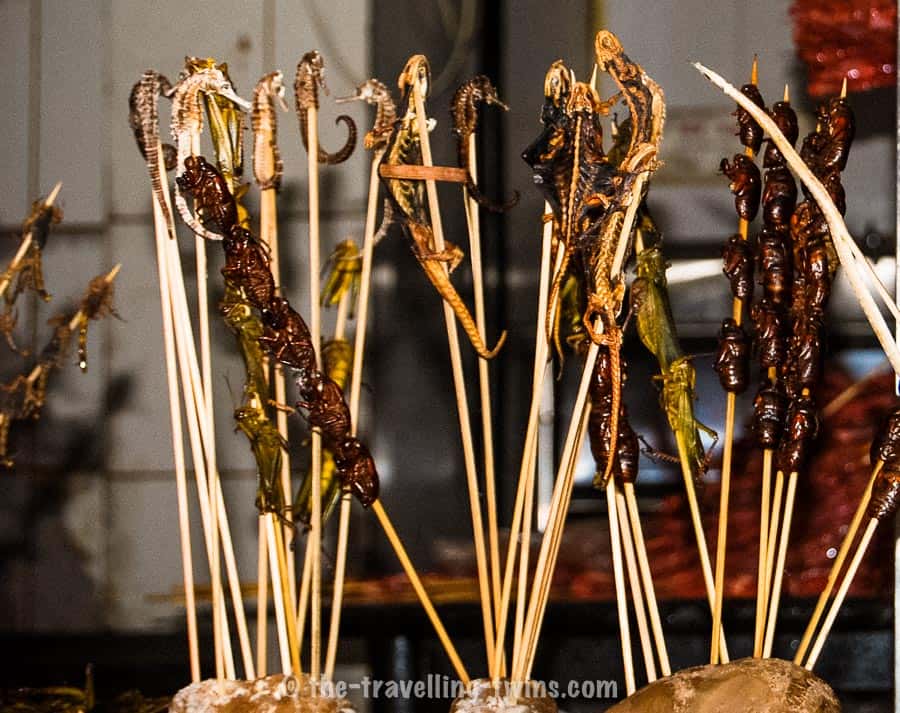
Still curious about the world’s weirdest foods, and to give you something wider than my own experience, I have asked other bloggers to contribute. Read on to discover the weirdest foods in the world.

Weirdest “eatable” creepy crawlers
Snake and Scorpion in Siem Reap
If you ask my daughters what their favourite food in South East Asia was, they will both reply BBQ snake. We have eaten a BBQ snake and Scorpion during our family holiday in Cambodia.
According to my daughters, the grilled snake was a delicacy and tasted better than chicken. In my opinion, it felt rather like a leather shoe full of small bones, but they like it so much that when we were exploring Siem Reap every night we were visiting Pub street and buying weird snacks. It cost only $1, so it was a small price for kids entertainment.
Eating such weird food is the result of Khmer Rouge regime when Cambodian people had to find an alternative sources of food. Check more interesting Facts about Cambodia.
One night we decided to try Scorpion as well, unfortunately, the moment I bit the Scorpion I realized that the place I bite is a place where scorpion poos and that was enough not even to want to bite it again.
Snake is a popular food in lots of countries for example in the United States you can try deep fried rattelsnake.
Mopane worms in Zimbabwe
The weirdest foods I’ve ever tried were Mopane worms in Zimbabwe. They are called worms but are in fact caterpillars of the emperor moth, which are native to Southern Africa. Mopane worms are traditionally eaten mainly by people in the rural areas of Zimbabwe, Botswana and a small part of South Africa for whom it’s an important source of protein. It’s not something you will find on the menu of a restaurant or on the shelves in supermarkets in larger cities.
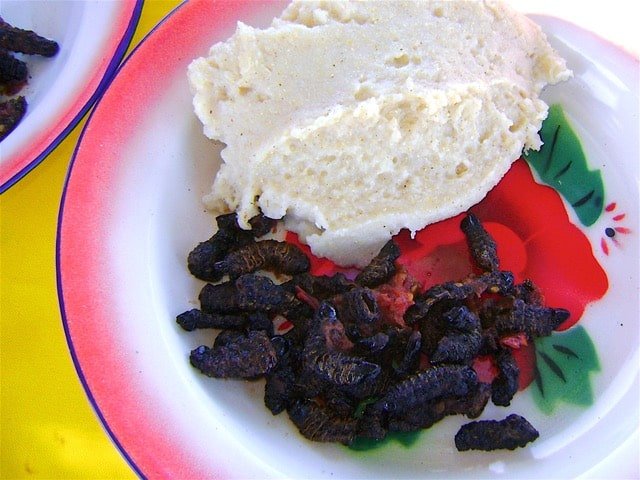
Mopane worms are handpicked straight from the Mopane trees after which they are dried and sold at local markets.
I’ve eaten the Mopane worm on various occasions; the taste is not bad at all. It has the flavour and texture of a very well cooked steak. It’s just a bit weird to eat because of the way it looks, and not really for the flavour. It’s not something I will look for on local markets to cook for myself; however, I would eat it again if it’s served to me, out of respect for the local culture.
Contributed by Sabine from The Travelling Chilli
Chapulines – Grasshoppers in Mexico
Adventurous eaters in Mexico shouldn’t miss trying chapulines or grasshoppers. This traditional indigenous snack is most widely consumed in Oaxaca. It’s also popular in Mexico City and surrounding areas.
The insects are roasted on a comal, or traditional griddle. They are then seasoned with chile, lime, garlic, and salt. You can find them most commonly during Mexico’s rainy season.

Chapulines are packed with protein and crunchy. The flavor is like spicy dried shrimp. The small ones are quite tasty! They can be eaten separately as a crispy beer snack or as a filling for tacos or tlayudas, or Mexican flatbreads.
In Mexico City, a great place to try chapulines is the massive La Merced market. There, you can also try other iconic delicacies like tongue and tripe tacos, gusanos (worms), and flying ants.
contributed by Ingrid from Second Half Travels
Fried Tarantula from Cambodia
A few years ago, I kicked off a two-month long backpacking trip around Southeast Asia with an Intrepid Travel group tour through Cambodia. During one of our long drives between cities, we pulled over to a large roadside market. The market sold standard road trip snacks like sodas, chips and sweets, as well as a few more unique items–fried grasshoppers and tarantulas.
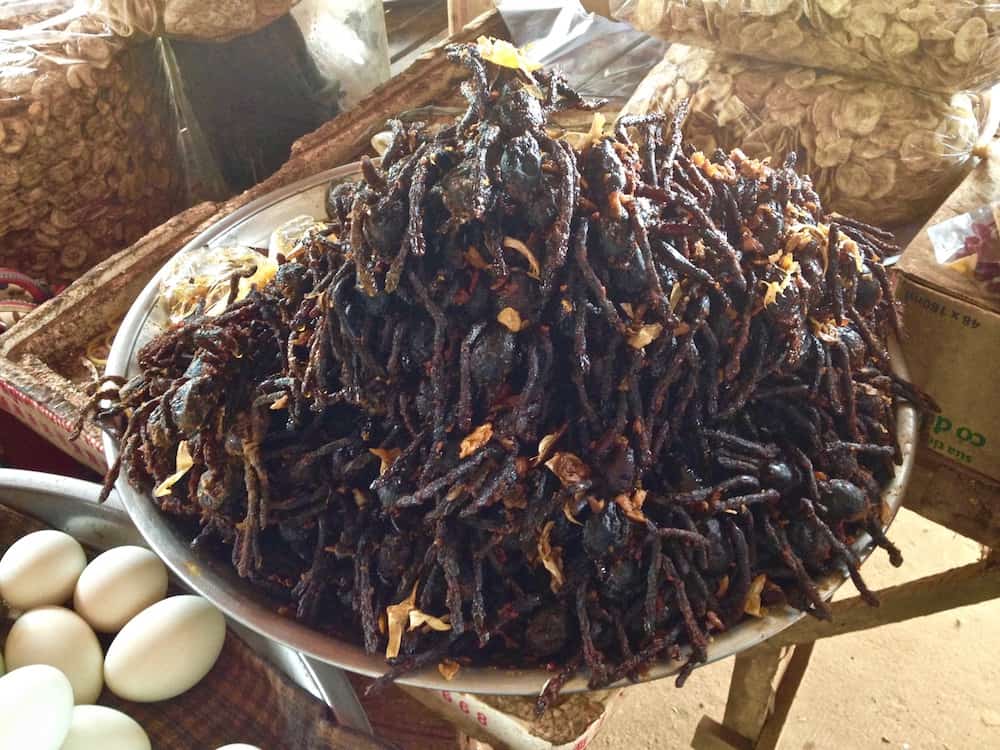
After some encouragement from our guide, our group purchased a few tarantulas to see for ourselves why they’re so popular. I grabbed one of the legs and took a nibble–it was crunchy and had a barbeque flavor, so it tasted much like a potato chip. If I didn’t know what I was eating, I would never have guessed it was a fried spider. (I wasn’t brave enough to try the abdomen, though, which squirts out creamy liquid when you bite into it!) Overall, I’m glad I tried it, but I definitely wouldn’t eat it again.
Contributed by Brianne Miers from A Traveling Life
Weirdest meat dishes in the world
Ox head
We had the wonderful experience of joining a family in a mountain oasis of Misfat al Abriyeen in Oman to eat an ox head which had been cooked for two days (shuwa) in a communal underground fire pit to celebrate Eid. Two days earlier we had been in the same house to witness the butchering of the same animal with knives and handsaws.
Here in pride of place on the roof terrace, we saw the animal’s head lying on a dish with an orange in its mouth being daubed with the marinade and wrapped in banana leaves. After this, it was wrapped in a sack labeled with a piece of iron and placed with similar offerings from the other families in the communal village fire pit. You can read all about it here (link)
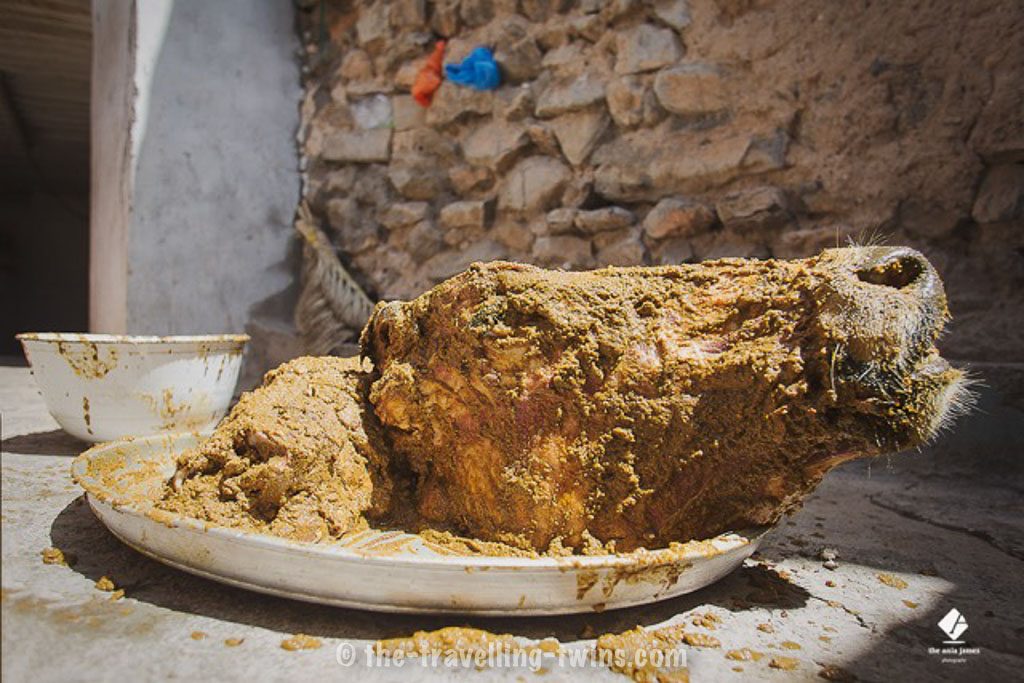
Our view:
- seeing the meat prepared before eid – horrific;
- sharing the feast with the family – deliciously tender and tasty and a beautiful experience.
Contributed by Ania from The Travelling Twins
Cuy – Guinea Pig
In South America, there is perhaps no food to try, which is more taboo than a guinea pig. Also known as cuy, this fluffy rodent has been on menus as far back as 5,000BC! I first tried guinea pig in the popular expat town of Cuenca in Ecuador; however, it is a popular delicacy in Peru as well.
Although many morally disagree with eating guinea pig, there are arguments which say, as a carbon-friendly beef alternative, it is far less damaging for the environment.
It is easy to pick up cooked guinea pigs all over Ecuador and Peru, but I had been told that it is best to try it in a reputable restaurant as the cooking really impacts the taste. With this in mind, I headed to Tres Estrellas, an upmarket local restaurant.
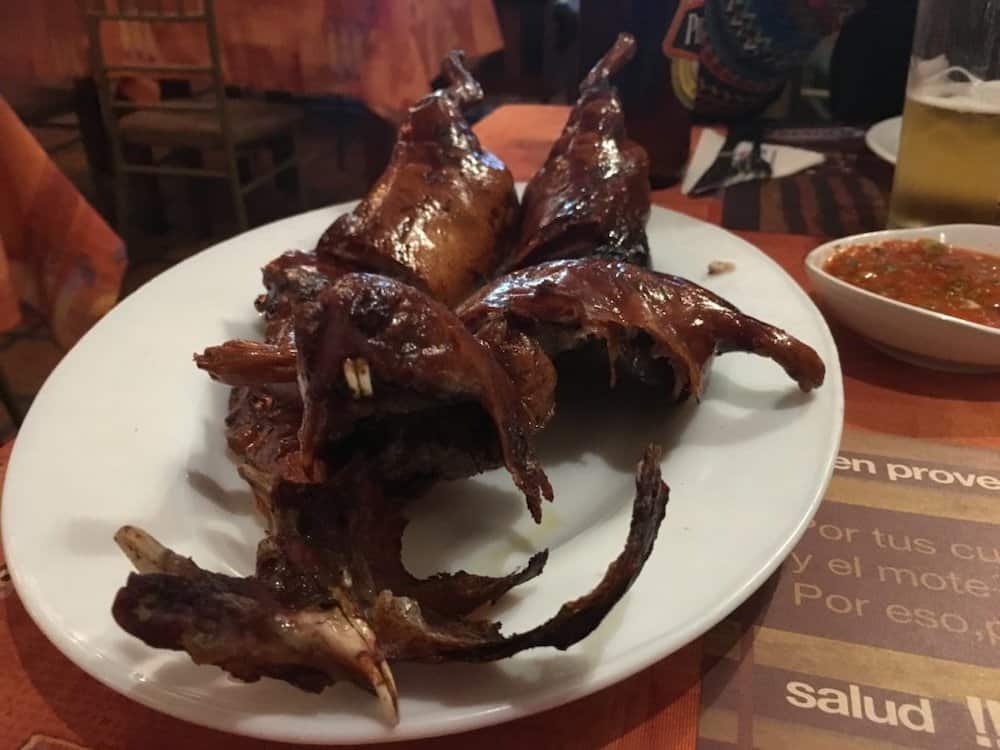
When the cuy was brought out, I was initially shocked to see how similar it looked to an actual living guinea pigs. It was whole and I could still see its teeth!
Despite its somewhat unappealing appearance, I wholeheartedly enjoyed the dish. The guinea pig had been roasted on a spit which meant that the skin was very crispy. It was salty and tasted somewhere between roasted chicken skin and pork crackling. The meat itself tasted gamey, much like a rabbit. The cuy was served alongside potatoes, beans and corn. If you can get past the way the dish looks, it makes for a delicious meal!
Contributed by Sheree from Winging the World
The Tiet Canh in Vietnam or Czernina in Poland
At first glance, it looks like tomato sauce, with its beautiful crimson red color. But beware of appearances! Tiet Canh is a traditional Vietnamese dish, the primary ingredient of which is duck blood. Rest assured, the blood is not simply served as a soup, but embellished with various spices and presented in various forms … which do not take away its freshness or its redness. Once the track of the tomato has been ruled out, it is difficult to conceal its true nature!
Polish had similar soup from duck blood called Czernina or Black soup, though it’s rather brown-black. according to the Polish tradition, “czernina” is served by the family to the daughter’s lover to tell him politely that he should not ask for his daughter’s hand because his proposal will be rejected anyway
Dromedary Burger
On our way to the stunning Moroccan Sahara desert, we stopped in Fez. After spending the day in the Medina and souks, we sampled dromedary burger. Dromedaries are a type of camel with one hump, sometimes called the Arabian camel as they are found in North Africa and the Middle East. Dromedary milk is sold widely, there are often stalls at the side of the road but the milk is not pasteurized or sterilized and can upset the stomachs of those used to more sanitized milk. Dromedary meat is used in Moroccan cooking on special occasions, slow baked over low heat in traditional tajines with vegetables. The meat can be tough and gamey if it comes from older dromedaries and trying to negotiate and buy the right cut for a tajine can be challenging! The dromedary burger, however, is made from ground meat from around the hump (a fatty lump, not actually filled with water) which also cooks well as steak. Dromedary meat tastes like beefy veal, quite juicy and flavoursome; in Morocco, they add spices to the burger meat giving it a delicious and unmistakable Moroccan flavour. I’m not sure it will catch on in the burger chains, but you have to try dromedary if you’re ever in Morocco!
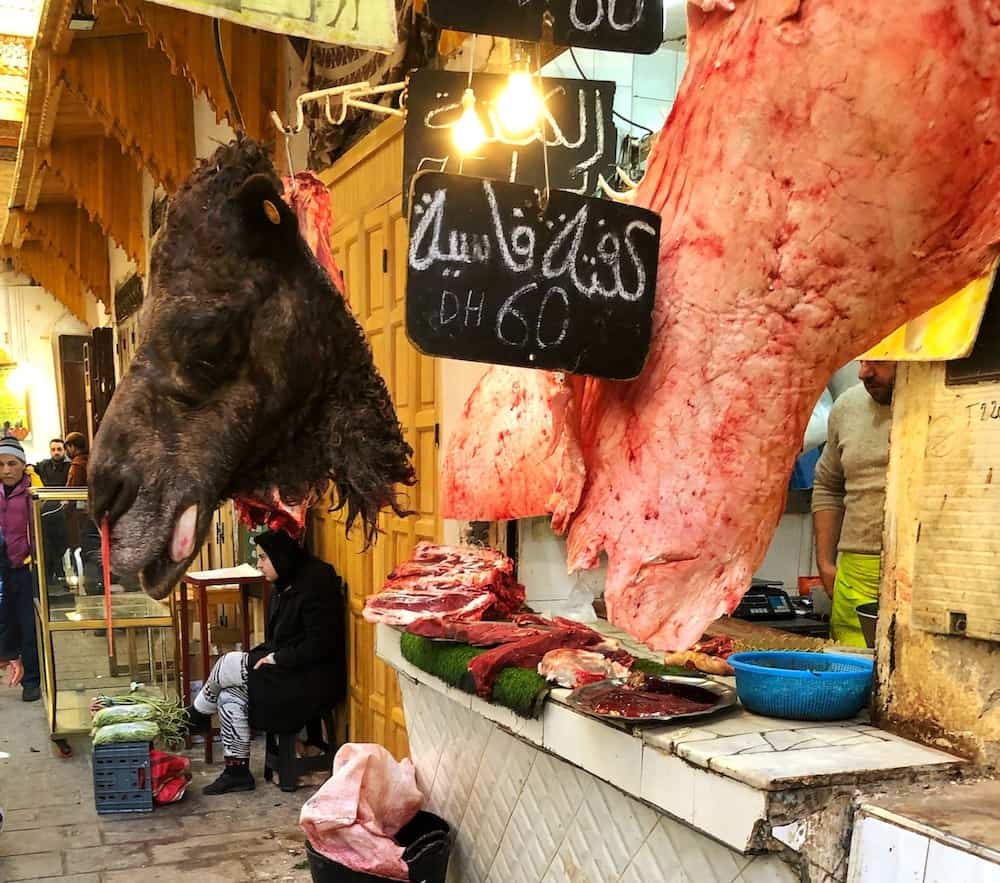
Contributed by Izzy from The Gap Decaders
Paaya from Pakistan
Paaya or paya means legs in Hindustani and, well, this is exactly what it is. It’s a heavy soup that consists of anything related to legs – may it be from goat, beef, buffalo or sheep. We tasted this dish in Pakistan because we love trying new food. Back then we didn’t know what was in it actually and just gave it a try. Result? We loved it.
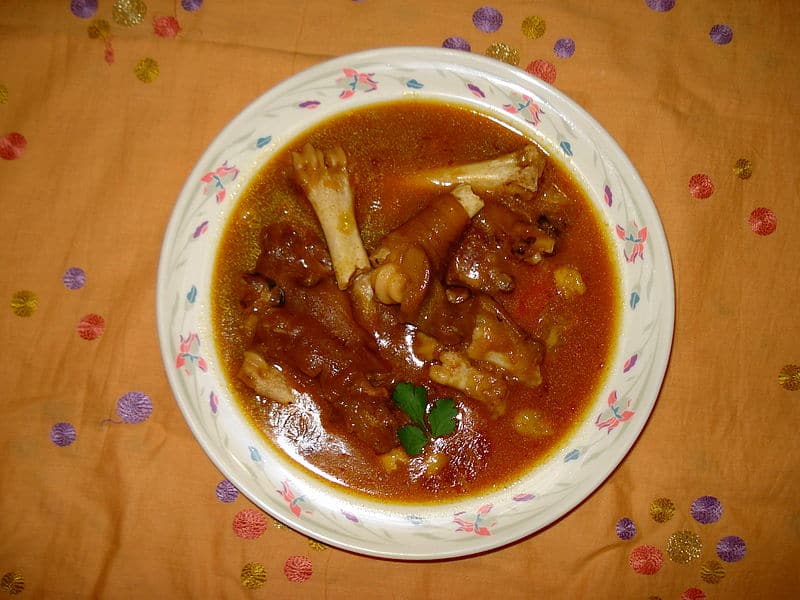
After that, we did some research and found out that it was actually mostly the Muslim cooks of Lahore and Hyderabad who adapted the Central Asian dish to their cuisine. Today, you’ll mostly find the same type of paaya in Pakistan: It is often based on a soup created by onions and garlic and mixed with lots of curry-based spices. Then the cook adds meat and boned of anything but pork and chicken and lets it cook for several hours. To be honest, having a look at paaya will give those who are not into the meat the chills, but trust us, this really is a good stew that may even remind you of the dishes your granny used to cook.
For those travelling to India: You can also find Paaye in Indian restaurants mostly under the name “khurode “, which comes from the word hoof.
Contributed by Clemens from Travellers Archive
Crocodile carpaccio
South Africa is a top destination, especially for families, because there’s so much to see and do there. It’s also a huge destination for foodies and offers very high-quality food in some amazing restaurants, although we prefer to have a more leisurely family-friendly picnic on a wine estate.
If you’re looking for something a little more exotic, then we recommend heading to Oudtshoorn. Oudtshoorn is in the Klein Karoo, a desert region in the Western Cape and is a great place to stop if you’re driving the famous Garden Route. It is well known for its ostrich and crocodile farms and is, of course, a great place to try crocodile.

When I saw a crocodile on the menu of the bed & breakfast I was staying at, I had to try it. I chose a crocodile carpaccio dish that was served in thin slices. It tasted a little like chicken. Actually, it had a bit of a fishy chicken flavour. I’d say it was an acquired taste but everyone’s tastes are different and how can you pass up the opportunity to eat something so extraordinary that you may not get to try again?
Contributed by Jacquie from Flashpacking Family
Zebra meat
There aren’t too many places in the world that serve high-end zebra shish kebabs, but Joe’s Beer House, on the outskirts of Windhoek, Namibia is one of them. The restaurant is a wonderful find – a hybrid German/African barbeque outdoor eatery with a tiki bar vibe. Aside from being an amazing venue, the highlight of the restaurant is the incredible menu, offering all sorts of weird and wonderful animals – many of which you’re likely to see on a safari game drive. After much deliberation, and wanting to try something I was unlikely to see on a menu again, I ordered the zebra kebab. It came with a salad and rice, and looked much like a lamb kebab, with five or six large chunks of dark meat. The taste was extremely potent, and a little tougher than I’m used to, and although I soldiered on for a while I wasn’t able to finish my quirky African feast – no matter how much Windhoek larger I tried to wash it down with. I’m glad I tried it, but zebra is definitely not a dish I’ll be ordering again!

Contributed by Ed from Safaris Africana
Sea Dog – lizard on a stick
Wangfujing Street in Beijing used to come alive at night, with market stalls lining the streets selling all sorts of weird and wonderful delicacies for tourists to try. These days, “snack street” as it’s otherwise known, is only open during the day. But you can still sample grasshoppers, crickets and other fried creepy crawlies.
This “Sea Dog” as the locals called it, was around $5 apiece. It was hard and crunchy, and mostly bone from what I can tell. To this day I have never figured out exactly what it was. They called it a sea dog, but it really does look more like a lizard than anything else? What do you think it is?
Contributed by Rachel from Round the World Rachel
Escargot (edible snails) France
In southwestern Europe, edible snails are a real culinary delicacy. They are a national food in France. The best are the burgundy-style shells with garlic butter and parsley. But Edible snails (escargot) are a valuable culinary delicacy not only in France.
In Portugal they are called caracóis, and they are a stewed dish containing various additives – white wine, garlic, piri-piri peppers, oregano, coriander. Larger snails, called caracoletas, are grilled with butter sauce.
In Spanish cuisine, small and medium-sized edible snails are called caracoles and are served with a spicy sauce or in a soup.
In Marocco, escargots are common street food served in small bowls with garlic butter and tooth pick to pick them from the shell.
Tripe in Florence
Eating Tripe in Florence is a not just a tourist experience but a sought-after treat of sorts for Florentines. Either you love it or hate it.
Tripe is the stomach lining of an animal, typically a cow. Tripe is also known in Florence as ‘Lampredetto’.
The tripe itself is made from various parts of a cow stomach, Lampredotto, however, is made from the final part of the cattle stomach, the ‘abomasum’.

It’s street food in Florence Italy, and is known as student food (originally peasant food) given its low price and that it’s filling when wrapped in a chunky sandwich. Tripe is eaten in various countries around the world, but Lampredotto is a local speciality for Florence.
Lampredotto is the fourth and final stomach of a cow. It is usually slow-cooked with tomato, onion, parsley, and celery until it has the texture of tender roast beef.
It’s usually served on a crunchy bun, but it’s normally soaked first the broth and with spicy or green sauce.
The texture is somewhat like stewed calamari but not as rubbery, and the taste is quite neutral, but when combined with other ingredients in a sandwich is absolutely amazing!
You can find it at street level in touristy places and is an ideal filler lunch if you’re on the go. So if you’re heading to Florence, skip brunch and head out for a Lampredotto for lunch to keep you going for the afternoon!
Buon appetito!
Contributed by Matt from It’s all in Italy

Do you want to learn more about Italy – Read Interesting facts about Italy
Brain Curry in Pakistan
Brain curry (known as maghaz) is certainly the weirdest food I’ve ever tried in all of my travels! I sampled this gooey-chewy dish in Pakistan at Phajja Siri Paye, one of the best places to visit in Lahore for traditional meaty eats.
The brain pieces were swathed in a curry mixture, which made the taste not so different from a regular curry meal. I’d compare the texture to some sort of mushroom- a bit spongy, though not quite as dense. In true Pakistani style, I used pieces of fluffy tandoori naan to scoop up the maghaz.
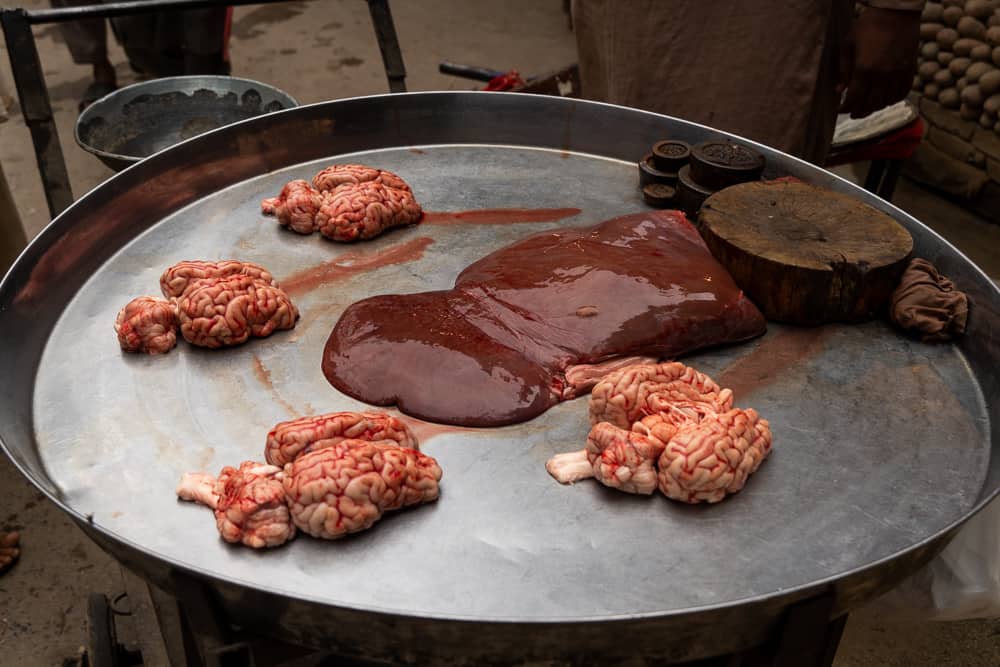
Personally, I enjoyed it. Nevertheless, I was a bit worried about how my stomach would react since it was my first week in Pakistan at the time. Luckily it went down (and stayed down) easy! I consider myself to be an adventurous eater and will try virtually anything- as long as it doesn’t have cilantro on it that is. Since I only tried maghaz once, I would definitely be up for a re-taste!
Contributed by Samantha from Intentional Detours
Haggis Scotland
Haggis a traditional Scottish dish made from sheep offal – heart, liver and lungs minced with oats, salt and spices and traditionally cooked in sheep’s stomach.
Traditionally it was done by Scott to use all the perishible offal quickly inside animal’s stomach after hunt. later Scott prepare haggis from sheep offals. Now haggis sold in supermarket is already pre-cooked. there is as well vegan version of haggis.

Haggis is a Scottish food made from the heart, lungs and liver of sheep or calf stuffed into an animal’s stomach. The ingredients are mixed with onion, oatmeal and suet that has been boiled in water for at least three hours before being packed down around it to make sure none can be lost when boiling takes place.
To my surprise, Haggis was not only one of those foods you see on lists like “Top Ten Weird Foods Around the World” but also considered as Scotland’s national dish! Check more interesting facts about Scotland.
Contributed by Ania from The Travelling Twins
Bull testicles – USA
One of the weirdest foods around the world is a dish called Rocky Mountain Oysters. The dish has no connection to seafood besides the name. They are not Oysters, but Bull testicles are being served under this name and they’re just as tasty when you fry them up with some salt, pepper, butter or even breading! I’m guessing that’s not what most people want to see on their plate for dinner though…
Sour swallow (Laos)
Whilst many Laos foods are unusual, the strangest I’ve encountered so far is sour swallows, or nok ann toong, in the Lao language. A seasonal delicacy, the sour swallow is a speciality of the little-visited Xieng Khouang Province in northern Laos.
During the months of August and September each year, flocks of migratory swallows travel long distances from Russia to Laos in order to avoid the freezing winter temperatures. The tiny birds, once caught, are placed in huge jars and left to pickle and ferment. Once ready, the fermented birds are fried and eaten whole as a snack with sticky rice.
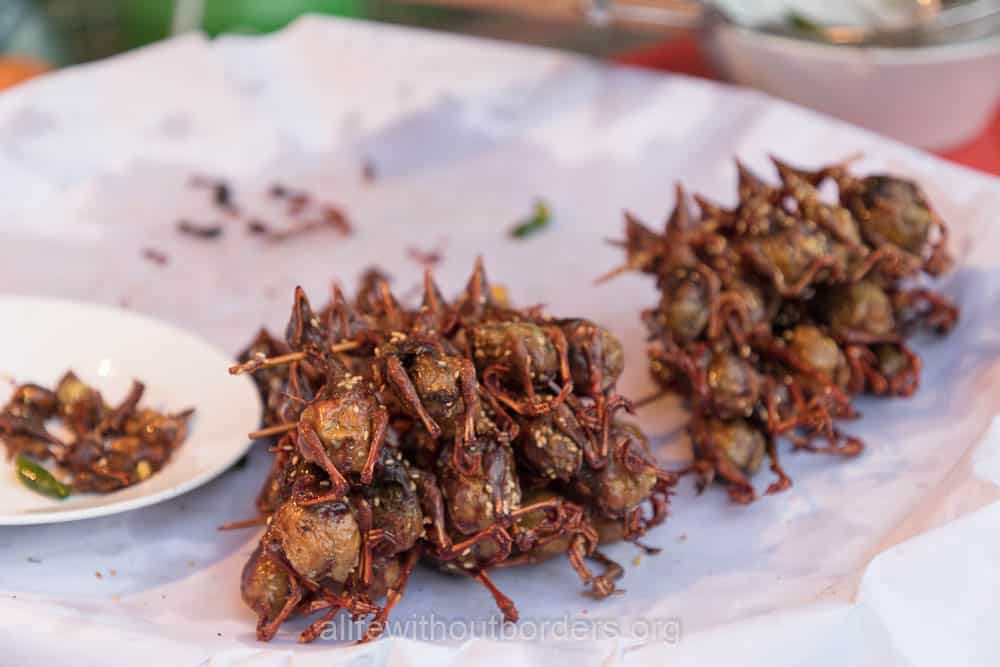
This local delicacy is usually only found in the latter part of the year at the fresh markets in Phonsavan, the capital of Xieng Khouang Province, and neighbouring areas. After much persuasion I tried sour swallow and let’s just say if the taste doesn’t put you off, the texture will! These little birds are not only highly pungent and overpoweringly sour – you’ll also need a strong guts to power your way through all the little crunchy bits of bone and beak!
Whilst I’m glad I was able to try Laos’ famous nok ann toong, for me it will definitely be a once only experience!
Contributed by Marie from A Life Without Borders
Pie, Mash and Liquor
One of the weirdest foods I’ve tried has quite a history. London’s Original Street Food was “pie, mash and liquor” and was based on the available produce around at the time. Back in the 18th century, the River Thames, running through England’s capital city, had a plentiful supply of eels and potatoes were cheap and easily available. Pie men used to sell eel pies from carts on the street, moving to small premises when money became available. Some of these original pie shops are still around in London’s East End and you can try the modern-day version of this dish.
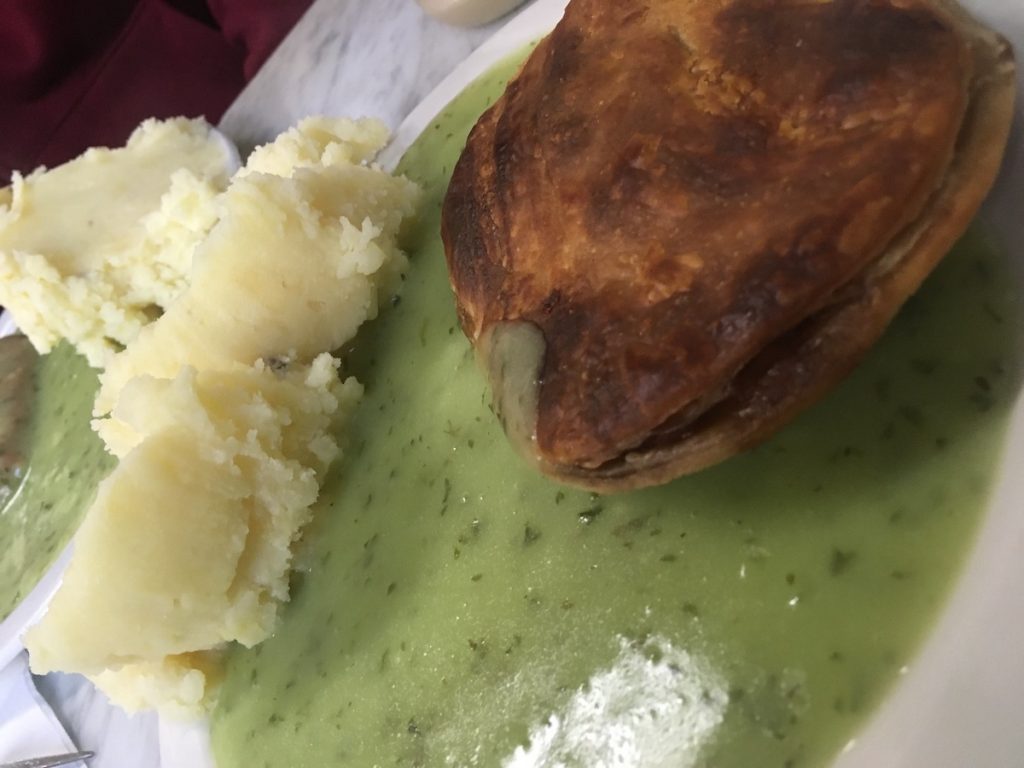
Today’s pie, mash and liquor in London uses minced beef or vegetables in their pies – not eels. The mashed potato is still the same though and the liquor recipe– which used to be made from the water that the eels were cooked in, is now a closely guarded secret, with the main ingredient of chopped green parsley and additional secret family ingredients.
The correct way to eat pie, mash and liquor is to cover your pie with liquor, and then sprinkle lots and lots of salt and vinegar on it. The best place to try pie mash and liquor is at the oldest remaining pie and mash shop – Manzes at 87 Tower Bridge Road, Bermondsey.
The salt and especially the vinegar do add to it, as the taste is somewhat bland, but judging by the number of locals lining up when we visited, it’s still very, very popular in London’s East End!
Contributed by Sarah from A Social Nomad
Sichuan Hotpot
The weirdest food I’ve tried during my travels is Sichuan Hotpot, one of the best foods in Chengdu. The hotpot itself is not so strange – a big vat of oil, chillies and stock mixed together and placed on a hob in the centre of your table. The strangest part is all the meats you’ll get to cook yourself in the table.
You can order the small and large intestines, three different parts of the stomach and chicken feet. I have to say the chicken feet have no meat on them so were not my favourite. The intestines were very grisly and rubbery. The stomach was actually quite tasty!
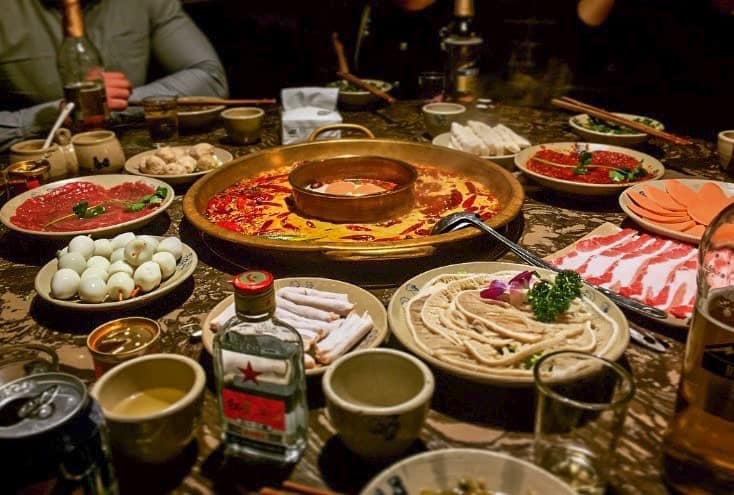
Don’t forget to try the pig’s brain. Getting it into the hotpot with just chopsticks is hard enough, but watching it float around for 20 minutes while it cooks was just another level of strange. I didn’t have the guts (no pun intended!) to try the brain myself, but my boyfriend described it as mushy and full of flavour. Last up to try is Stinky Tofu! The smell on this is just as weird as its taste. I have to recommend trying it though, as it’s a big deal in Sichuan.
Overall, Sichuan Hotpot is one of my favorite meals I’ve tried throughout the world. You can also have the option of ordering some ‘normal’ meats and tofu but where’s the fun in that!
Contributed by Hanna from Hanna’s Happy Adventures
Weird eggs dishes in the world
Balut – the hard boiled duck fetus
In the weird dishes discussion, balut from the Philippines must surely take a medal. The contents of this hard-boiled eggshell is not an egg, it’s a fertilized (usually duck embryo) egg – which has been incubated for two or three weeks, and then boiled. It means when you break the shell, beside some white which you may be expecting, you get feathers, a beak and a mixture of flesh and some dribbling slime.

That discovery was the moment I knew I couldn’t fool my stomach. It’s not an egg anymore if something stares at you. Probably that’s why balut is mostly eaten at night when you cannot see what you are eating, or as a bite when you are drinking. I tried it this way at night on the beach in Coron, while having a drink with my Filipino friends. My friends dared me to try it and I did bite it, it felt salty, and then I felt the feather and texture before the previous content of my earlier supper met the balut in the (previously) fresh air.
But lots of Filipinos find that balut has aphrodisiac properties. It apparently stiffens your knees too. That’s probably the reason why you can buy balut almost anywhere around Manila. Taste-wise it wasn’t horrible, but the impact of mind and guts on the matter of unborn chick was impossible for me.
Contributed by Ania from The Travelling Twins
Century egg
I remember how I once innocently picked up a black century egg from the shelf in a Malaysian supermarket when we were visiting Kuala Lumpur with kids.
“Great, it’s a black-shelled egg – let’s buy it and try it.” I said to the girls. I don’t know what my expectation was, but the taste of this egg was revolting. The “white” was dark brown and translucent, and the yolk was dark green. The whole egg strongly smelt of ammonia.

So what is a century egg and how is made?
Preserved egg, or hundred year old egg as it is also known, is a duck, chicken or quail egg which has been packed in a mixture of clay, salt, lime, ash and rice husk. There it stays for several weeks or even months. That was the traditional way of preparing century eggs. Currently, the process is accelerated by adding link oxide or zinc oxide.
Eggs are eaten as a side dish on their own. My own recommendation is to avoid them altogether. After just one bite of mine, I developed a big headache. In case I haven’t persuaded you yet, maybe you should know that in Laos and Thailand, the common name for the century egg translates as “horse urine egg”.
Contributed by Ania from The Travelling Twins
Bird’s Nest Soup
People often find themselves intrigued by the strangest of foods. Bird’s nest soup is one such food that has been famous for being an expensive delicacy and where it comes from. People might be surprised to know this dish originated in China, known as “swallow’s nest”. The ingredients are bird saliva and spit mixed with a few other things like hard-boiled eggs or tree bark! It can cost up to $1,000 per bowl because people believe that eating it will make them healthy again if they have ingested poisons or suffered illnesses. This may seem gross but some say honey bee larvae taste even worse (or better).
Bird’s nest soup was served in the hotel in Coron, but we didn’t tried it was too expensive.
Weirdest fish dishes in the world
Pufferfish the most dangerous food in the world
Pufferfish is one of the most dangerous foods to eat, as the deadly toxin in the pufferfish is 1,200 times more deadly than cyanide. When I tried pufferfish sushi in Singapore, I didn’t know this. It was a treat from my friends. They explained that this sushi would be prepared by a specialist chef who would taste it himself twenty minutes before serving it to us. – only of course if he was still alive to do so!

Specialist pufferfish cooks have to serve a minimum of three years in training to get the special license which allows them to practice. In many countries, including the USA it is forbidden. In my memory, thin slices of pufferfish with caviar was one of the most delicious (and scary) things I have ever eaten.
Contributed by Ania from The Travelling Twins
The Conch
One of my favorite foods from The Bahamas is the Conch. Conch is a mollusk, an enormous sea snail, and can be prepared in a variety of ways. I’ve had it fried, they call it Cracked Conch, like ceviche, and my favorite way, stewed, they call it Steamed Conch.
While working on the dive boat, we pulled it up from the ocean floor and ate it raw on the back deck, still dripping saltwater. While onshore we’d heard from local Bahamians that we needed to try the best part of the Conch, the pistol. Local folklore states that this translucent, 3-inch long worm-looking thing is an aphrodisiac, and is also known as Bahamian Viagra. They believe it is the male genitalia, but marine biologists say that both male and female conch have one and that it’s part of their digestive system. It is odd-looking and not appetizing, but I’ll try just about anything on a dare, so I ate one. It had a rubbery texture, and no flavor, not as gross as it looked. I can’t say whether or not it worked as an aphrodisiac, or perhaps I won’t say.
Contributed by Lizzie Lau
Hákarl – Fermented Shark in Iceland
I am a foodie and a somewhat adventurous one. I’ve had several, shall we say, interesting foods in my extensive travels. However, one of the weirdest was the fermented shark I tried in Iceland.
During a tour around the entire island, we learned that fermented shark is actually considered a delicacy in Iceland. A popular way to eat the fermented shark is to chase it with the local liquor, Brennivín. A well-loved schnapps, the preferred method is to take Brennivín as a shot.
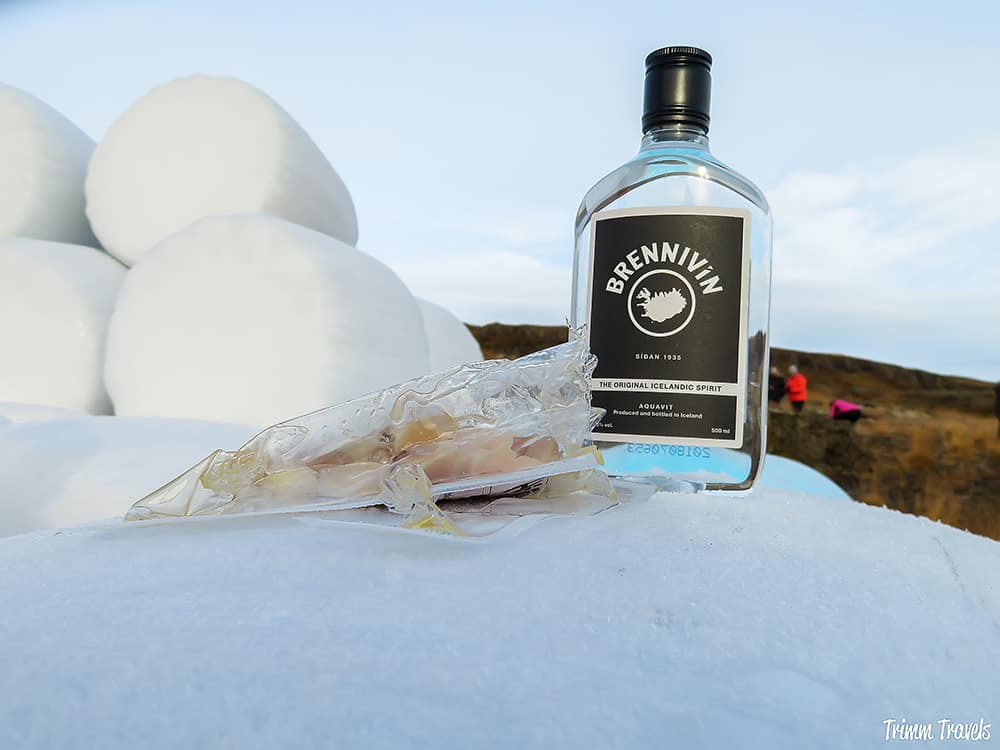
I can tell you it was! I had my fermented shark on a toothpick in one hand and a shot of Brennivín in the other and I’m proud to say that I nailed the entire experience like a local. Did I like it? It wasn’t my favorite but I didn’t hate it either. For me, it didn’t taste fishy or “bad”. It actually didn’t have much taste to it at all. By the time I chased it with the Brennivín, I really only had the lingering taste of the Icelandic schnapps anyway. However, some of my friends definitely experienced a fishy taste.
I always recommend going as local as you can with food when traveling. This traditional Icelandic food is served almost everywhere in Iceland including some of the best restaurant in Iceland
Contributed by Heather Trimm from Trimm Travels
Surströmming
Surströmming is fermented Swedish herring from the Baltic Sea. The fish is preserved with salt to prevent it rotting while fermenting. The fermentation process takes about six months, and the official day when everyone eats herring in Sweden is the third Thursday of August. This is when herring caught in springl should be fully fermented. Because of the smell, the herring is mostly eaten outdoors. It is traditionally served either on flatbread or with sliced or mashed potatoes
Surströmming is considered a delicacy in Sweden, but it doesn’t change the fact that it’s probably the smelliest food in the world. It apparently tastes much better than it smells.
Weirdest drinks in the world
Snake wine
I came across snake wine a few times while travelling around Asia. The first time was in Taiwan, where I didn’t dare to try it. The second time was in Luang Prabang, where they call it Snake whiskey, and we tried it. It tastes like any other moonshine.
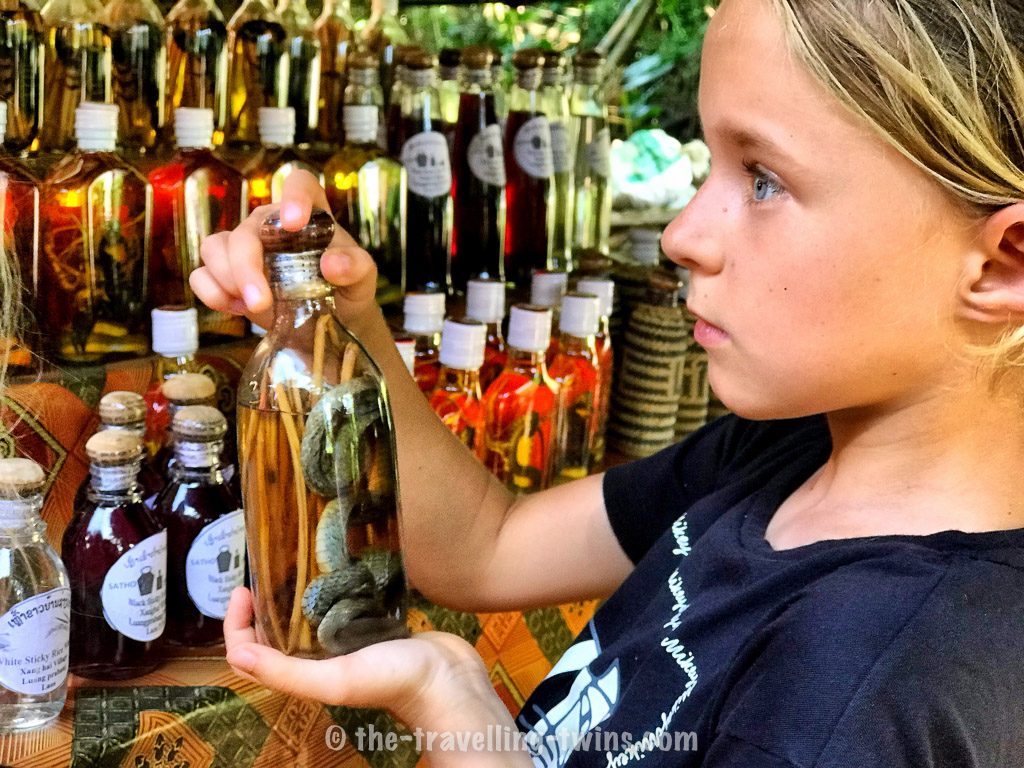
Vietnamese snake wine, known in Laos as snake whiskey is actually rice wine infused with the (pickled) body of a snake, reptile or arachnid – often a scorpion. The Vietnamese claim that snake wine is good for potency, though I feel that anyone who dares to drink from the bottle which has a snake inside must already have something about them. We Poles prefer to drink Vodka which is bottled with a blade of grass upon which a bison is supposed to have urinated. Each to their own!
Contributed by Ania from The Travelling Twins
Kymyz – fermented mare’s milk
Kyrgyzstan is a country with a nomadic past that still has a strong influence on the Kyrgyz culture and food. For example, horses remain an important part of the life of Kyrgyz people. In summer some people still take their horses up to the summer pastures while living in a yurt.
Horses not only provide transport and company, but also meat and milk. Kyrgyzstan national drink is Kymyz or fermented mare’s milk. The scenic Suusamyr valley is famous for its high quality of Kymyz and some even believe it has medicinal properties.

In the Suusamyr valley, you can visit the Baytor sanatorium for a multiple-day Kymyz treatment or buy it in reused bottles at the side of the road as I did. I think it is an acquired taste and I must be honest that I wasn’t a big fan of the slightly sour and fizzy alcoholic drink. Yet it is so important in Kyrgyz culture that it is a must try when you are in the country.
Contributed by Ellis from Backpack Adventures
Coffee Luvak
The first time I learnt about Kopi Luwak coffee was while watching the movie “Bucket list” (which until recently, I didn’t realise was responsible for creating the saying “bucket list”).

While exploring Bali, we visited a coffee plantation, where we learned about and tried Kopi Luwak. As you probably know, this is not only the most expensive coffee in the world but also has a laughable origin. The essential point is that the coffee beans are collected from the droppings of an Indonesian animal called palm civet (described as a “cat” in the movie).
The civet eats the coffee beans which he doesn’t fully digest, and then dumps them out. The civet-gut processed beans are then washed(!) and treated as regular coffee beans. Unfortunately, to increase productivity to meet demand, Asian palm civets are kept in small cages and force-fed with coffee cherries. In my opinion, this coffee tastes like any other coffee.
Contributed by Ania from The Travelling Twins
Weirdest desserts in the world
Wasp Crackers Japan
Eating wasps, the idea may seem strange, but in Japan, the dish is a classic served at aperitif time, to accompany sake. The good news? The wasps are already dead.
The biscuit very tasty, but when you are eating the wings of the insects protruding from the dough, which makes it the eating a bit discouraging.
As for cooking it, the principle seems simple, combining a dead wasp and a cracker machine – don’t try it at home instead go to Japan – it is more fun and less risky.
Chilli Ice cream in the Philippines
First introduced in 2004, the Philippines famous hot pink chilli ice cream has gotten hotter and hotter over the years. This sweet and spicy treat is only available in Legazpi City, also known as the home of chilli ice cream.
The 1st Colonial restaurant currently serves three different strengths of red hot ice cream topped with a real chilli. Laced with local siling labuyo chilli and coconut milk, you’ll be pleasantly surprised at how well the combination of hot and cold works.
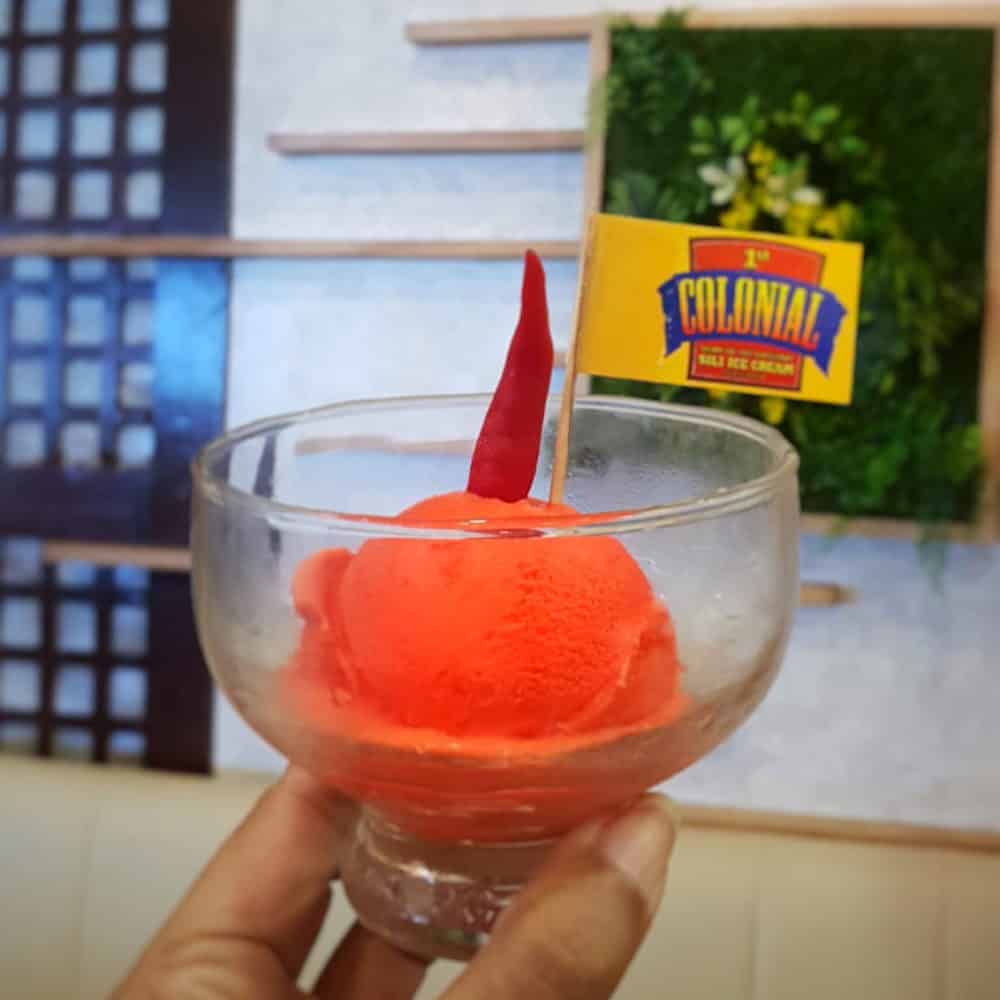
Three levels of spice exist as a challenge to customers. Level 1 is suitable for children, Level 2 has a tickling and pinching sensation and Level 3 also known as the Mayon Volcano level – has the strongest kick, and is even served alongside a shot of milk to balance the heat. I tried all three and would recommend giving this unique ice cream a go. Would you be brave enough to try the volcano strength level?
Contributed by Roshni from The Wanderlust Whitin
Mämmi (Finland)
One of the worst food experiences of my life was eating Finnish mämmi. Even After living in Finland for ten years, I consider it weird. It is an unusual looking traditional Easter dessert. Locals love mämmi, but foreigners have a love or hate relationship with it. If you travel to Finland during the spring, make sure you get some and give your own judgment. It is available in every grocery store before the holidays in bigger and smaller portions as well, but you can make your own too.

The recipe is simple. Mämmi is made of rye flour, malted rye, salt, and water. You can add a bit of orange zest too. It is baked in the oven overnight and chilled for three days. It is served with milk, cream, sugar or vanilla sauce.
In my opinion, the taste of this black, sweet and sour dessert resembles very well its tar-like look, no matter how you serve it.
Contributed by Katalin from Our Life, Our Travel
Tremella
One of the strangest foods I have eaten is Tremella. Weird firstly because I had never heard of Tremella before and secondly due to the surrounding mystery of our introduction. This introduction was during a trip to the beautiful city of Amsterdam and a visit to a wonder Michelin starred restaurant named Spectrum. On arrival, we were shown to our table where an interesting looking ‘table decoration’ caught our eye. Sponge-like in appearance; it sat there unassumingly under its glass cloche. Pale cream coloured, light and airy looking, unusual but unusually beautiful, this is Amsterdam after all. As we moved through the tasting menu, elements were discreetly added to our table guest, firstly a tarragon oil which turned its pale tone a vibrant green.
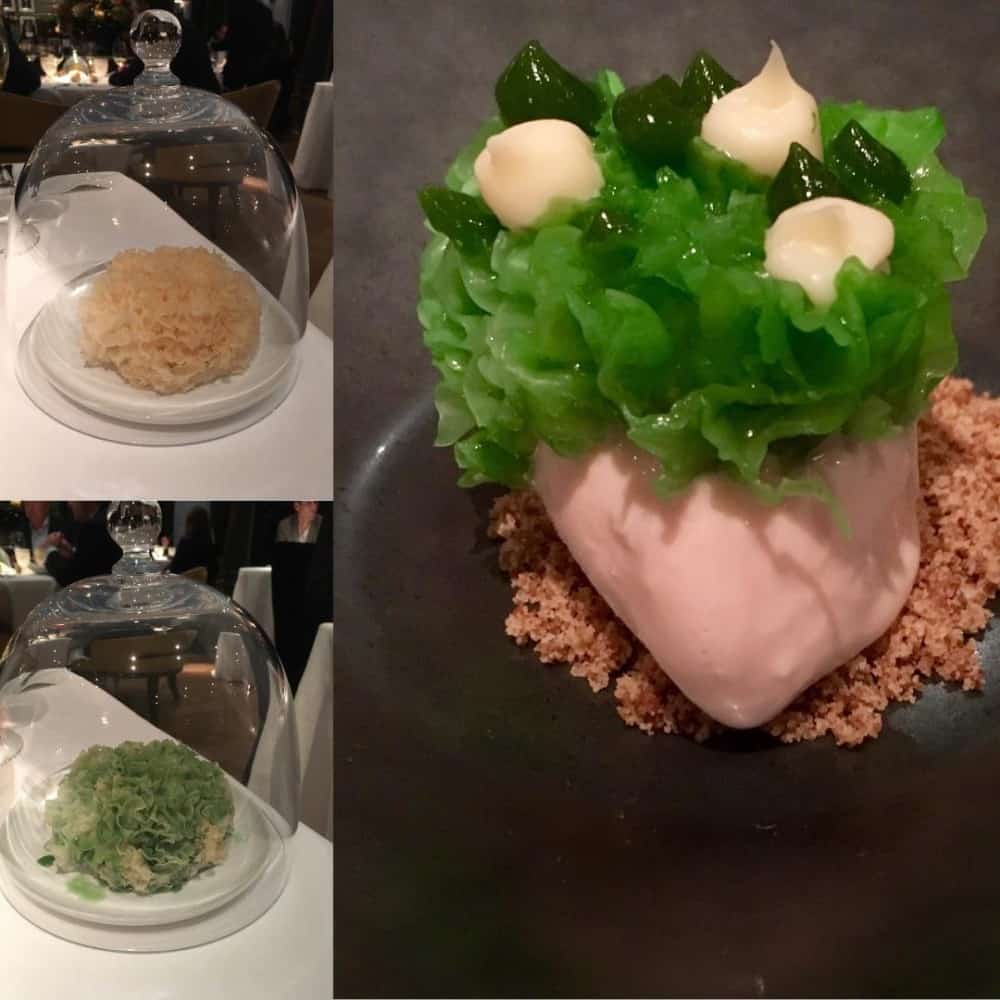
Arriving at the dessert course, some of the mystery was revealed. A section of our table decoration was put on top of our fabulous dessert, transforming it into Tremella, tarragon, peppercorns and BBQ white chocolate. But what is Tremella? Tremella is a Chinese fungus. Soft in texture and mild in flavour, it has medicinal benefits such as anti-inflammatory properties. I can tell you that it added theatre and intrigue to our experience at Spectrum and had us discussing it long after the meal. Most importantly, it added a delicious texture and flavour to another delicious dish on the menu.
Contributed by Melanie Varey from Two plus Dogs
Casu Marzu Italy- maggot cheese
I’m a big fan of Italy and Italian food, but one Italian dish I am glad I have never been served is Casu Marzu. Casu Marzu, meaning rotten cheese, is a soft cheese made from ewe’s milk and maggots. Yes you read correctly, maggots.
The maggot cheese is made only in Sardinia from Pecorino sheep’s milk, which is heated and then left for a few weeks to curdle. After this, the crust is cut off and the cheese left outside so that special flies can get in and lay their eggs. Once the fly eggs hatch, the larvae of course feast on the cheese. In doing so their acidic digestive juices ooze into the cheese-making it soft and gluey. When you cut this cheese you can find it jumping with tiny maggots.
Because I would never dare to try it, I can only rely what I read. Apparently Casu Marzu is strong and has a sharp taste. When you bite into it you are eating a mixture of fermented cheese and live maggots. Apparently the maggots are so small that you can’t feel them. They say the cheese is best taken with wine – no surprise there then!
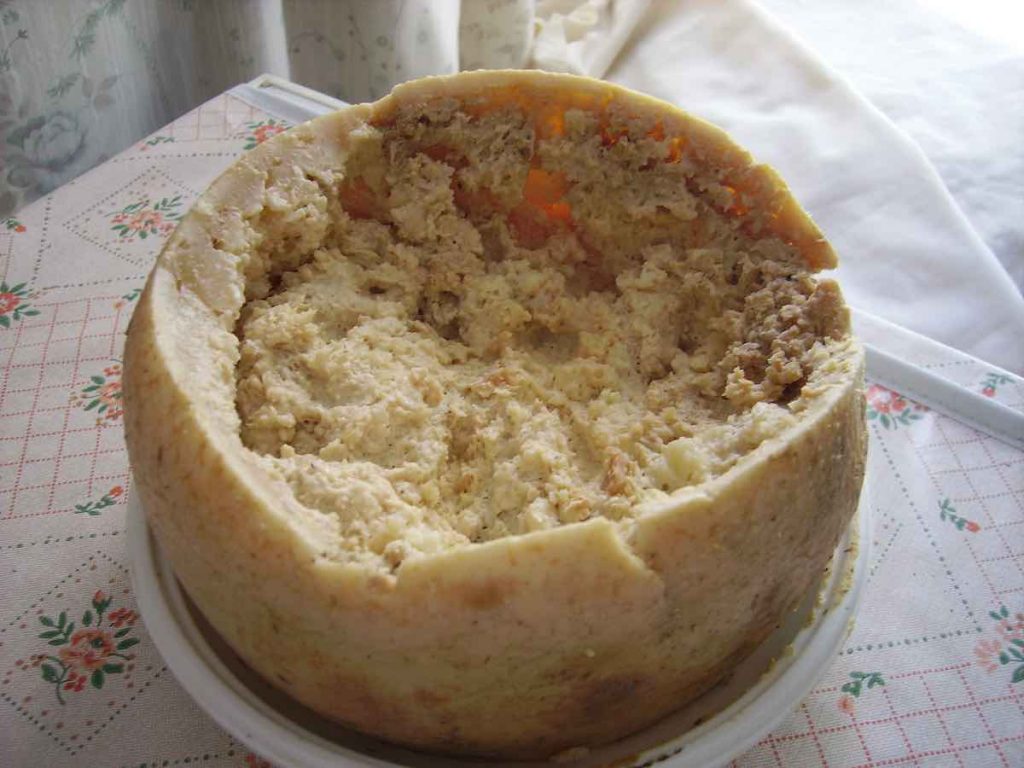
The sale of casu marzu is banned in the European Union but it is still produced locally in Sardinia as part of the island’s heritage. The traditional dish is served and weddings and other celebrations.
Contributed by Ania from The Travelling Twins
Weirdest foods made from vegetables
Stinky tofu
Stinky tofu is one of the most popular Taiwanese foods and has a very smelly reputation! The dish is served all over the country and is easy to find with many street food vendors in the night markets selling it. You will know when you are close to a stinky tofu seller as the overpowering rotten stench is really hard to miss.
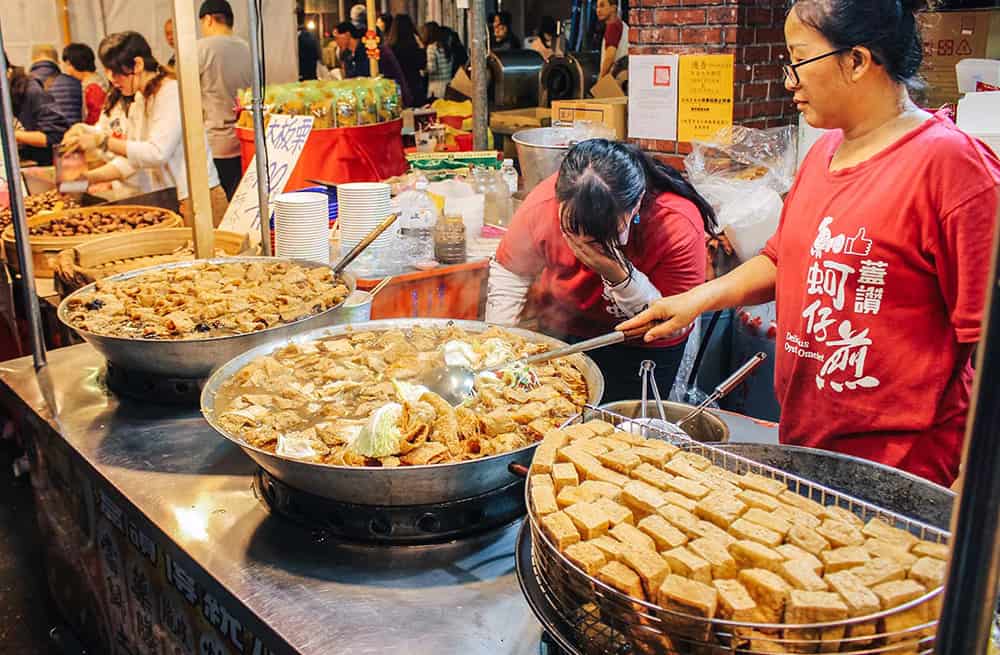
This iconic snack is made from cubes of firm tofu which have been soaked in a brine for weeks or even months (the brine is a mix of dried fish, meat and fermented milk). The tofu is then usually deep fried to serve, so it is crispy on the outside and soft on the inside, and accompanied with a sweet and spicy sauce or kimchi on the side.
The flavour is a bit of an acquired taste – slightly sour and a bit like blue cheese! Apparently the worse it smells, the better it tastes (there are 13 different grades of stinky tofu). Let’s just say it tastes a lot better than it smells and should be on your list of things to eat when visiting Taiwan with kids or without.
Contributed by Caroline from CK Travels
Dulse
Dulse is red seaweed, also called a “sea vegetable”, that comes from the Bay of Fundy (body of water between New Brunswick and Northern Maine and Nova Scotia). It is sun-dried, seasoned and eaten as a snack, although Canadians also put it in soups and salads.
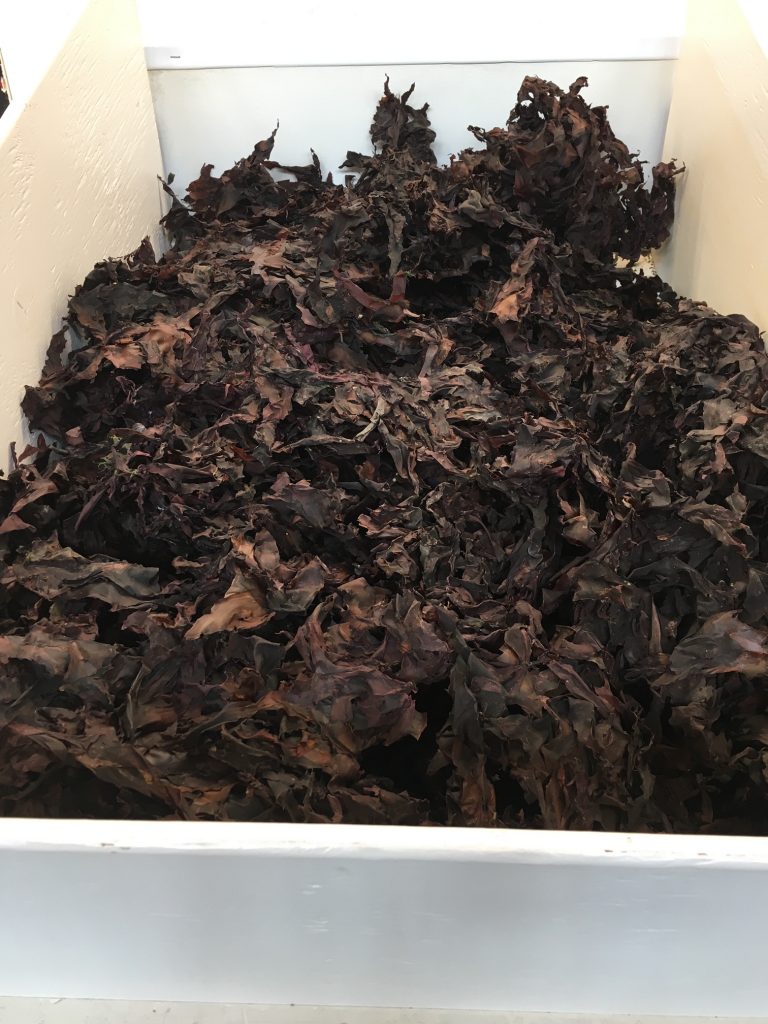
We were lucky to find a vendor at the Saint John City Market in New Brunswick that sold it by the brown paper bag. I heard it was chiplike, but it was much chewier than seaweed you find in a sushi roll. It really gave our jaws a workout. I would have preferred it with a slice of ahi tuna and some rice, or if it were more snappy like a potato crisp. Still, a great local find in an incredible farmer’s market.
Contributed by Lori from Maps Memories and Motherhood
Nattō from Japan
Nattō is pretty weird food – that is if you’ve never had any food like it before, which was the case for me. It’s slimy, stinky, stringy, and just plain strange both in smell and in taste. But the Japanese people we met on our travels loved it! And for a good reason. It’s actually a super healthy fermented food. Which means it’s great for your gut health!
Made from soybeans, Nattō originates in Japan and is often eaten for breakfast with rice, onions and sprinkled with soy sauce. Our first encounter with Nattō was at a sushi train that our couchsurfing host brought us to.
Apparently, he was excited to see our reaction to our first taste of Nattō. Needless to say, it was a taste I won’t forget. I couldn’t help but make a face in reaction. I can only describe it as a sharp cheese but on another level. Maybe on the first try, it’s worth holding your nose so as not to overload your taste buds.
Now, not everyone is going to love it like the Japanese. And to be honest, most people won’t even like it. My wife gagged when she tried it. But Nattō is a healthy, fermented food, so I recommend trying it at least once in your life. If you’ve really acquired taste buds, you may try it again in your life, heck you might even love it. One thing is for sure; you’ll undoubtedly remember the taste for a long time.
Contributed by Nick from Illness to Ultra
The weirdest food in the world – Pin it for later

Privacy Policy Disclaimer
This website uses affiliate links for income and support.
If you like our website, please consider using these links. You will be directed to the vendor, and we will get a small commission on your purchase price at no increased cost to you.
We have researched facts stated here as far as practicable but please check anything critical before committing your time and money. We do not claim any special knowledge or expertise, and we are not consultants for our readers.
